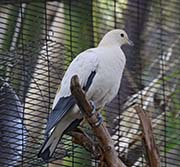Torresian Imperial Pigeon - Ducula spilorrhoa
| Length | |
| Wingspan | |
| Weight | |
| Clutch Size | |
| Chicks at birth | |
| IUCN Conservation Status | |
Continents: |
The Torresian Imperial Pigeon has also been known as the Nutmeg Pigeon or the Torres Strait Pigeon. They are a large pigeon and are white with black flight feathers. Parts of the tail and some spots on the undertail coverts are also black.
During the 19th Century, The Torresian Imperial Pigeons were slaughtered by thousands because they were considered a pest. Their populations have since been increasing and the bird is considered of "Least Concern" even though their habitat is being destroyed.
Diet: They primarily eat fruit but will swallow large seeds which are expelled whole.
Courtship: In Australia they breed between August and January in mangroves, vines, palm fronds on off-shore islands. The courtship includes the male flying steeply up, pausing, tipping forward and then gliding downwards.
Nesting: Nests are built in trees such as a coconut palm and are made of sticks. One egg is laid.
Habitat and Range: They are an arboreal bird that prefers mangroves and subtropic forests. They are found on New Guinea, Northern Australia including Queensland, Bismarck Archipelao, Indonesia, Papua New Guinea. In north-east Queensland, they migrate daily as flocks from the islands to the mainland rainforests to eat fruit, returning to the islands at dusk.
Vocalization: Vocalization includes deep mrrrooooo", "roo-ca-hoo" and "up-ooooo".
Plumage/Molt: Don't think they have an alternate plumage.
Migration: Full migrant.
Tongue/feet: No information.
Bibliography:
- http://en.wikipedia.org The Free Encyclopedia, Accessed June, 2012
- http://www.reptilepark.com.au Australian Reptile Park, Accessed June, 2012
- http://birdlife.org BirdLife International, Accessed June, 2012



